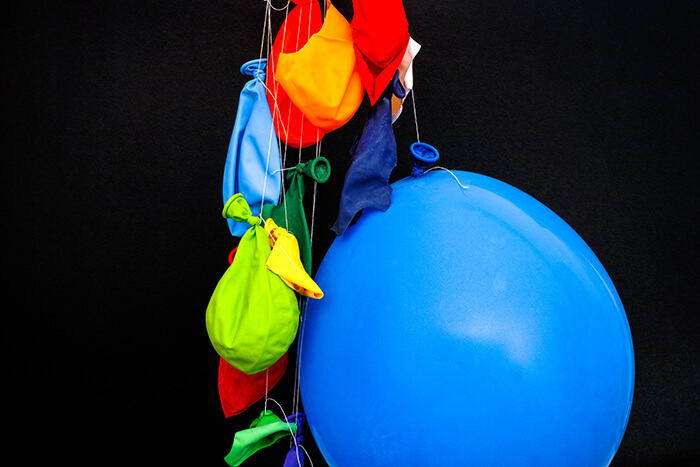[ad_1]
Why Do Balloons Deflate? | Share with a friend or pin for later!
I made a double flower cluster one morning using 9″ Qualatex balloons. I inflated them using a handpump and by evening I noticed 3 of the balloons started airing down. What am I doing wrong?
ANSWER
Balloons are a popular decorative item for any event or occasion, but they can quickly deflate, causing a lot of disappointment and frustration. So, why do balloons deflate, and how can you prevent it from happening? In this post, we explore the common causes of balloon deflation and how to avoid them.
- Temperature Changes
One of the most common causes of balloon deflation is exposure to extreme temperatures. Balloons are made of latex, which is sensitive to temperature changes. When exposed to high temperatures, such as direct sunlight or a hot room, the air inside the balloon will expand, causing it to burst. Conversely, when exposed to cold temperatures, the air inside the balloon will contract, causing it to deflate.
Solution: Store your balloons in a cool, dry place, away from direct sunlight or heat sources. Avoid leaving balloons in a hot car or outside in the sun for extended periods.
- Humidity
Humidity is another common cause of balloon deflation. When the air is damp, balloons absorb moisture, which weakens the latex. This can cause the balloon to deflate or burst.
Solution: Keep your balloons away from areas with high humidity, such as kitchens, bathrooms, and outdoor areas during humid weather conditions.
- Over-Inflation
Over-inflating balloons can cause them to become stretched and weak. This can lead to ruptures, leaks, and eventual deflation.
Solution: Use a hand pump or air compressor to inflate your balloons, and stop inflating when they reach the correct size. Don’t over-inflate, as it can cause the balloon to weaken and fail.
- Pinholes and Punctures
Small pinholes or punctures in the balloon can cause it to deflate slowly over time. These tiny holes can be difficult to detect, but they can cause a balloon to lose air quickly.
Solution: Use high-quality balloons that are less likely to have defects. Inspect your balloons before inflating them for any visible damage, and avoid sharp objects around the balloons.
- Quality of Balloons
The quality of the balloon can also affect its durability and resistance to deflation. Low-quality balloons are more prone to defects, punctures, and ruptures.
Solution: Invest in high-quality balloons from reputable manufacturers to reduce the risk of deflation.
Final Thoughts
Balloons are a fun, cost-effective, and colorful way to decorate an event or occasion. However, they can quickly deflate due to various reasons. Understanding the common causes of balloon deflation and following the recommended solutions can help you avoid the disappointment and frustration of watching your balloons go limp too quickly.
Air-filled latex balloons should normally stay inflated for days or even weeks. So I am not sure what happened in your case, especially as you used a high-quality brand like Qualatex.
Were the balloons new? Or did you have them at home for some time? Balloons should always be stored in air-tight containers, in a dark and dry location. Otherwise, the latex might get porous.
One other factor that could have contributed to the deflation is the temperature. In cold environments, the air contracts, thus making the balloon shrink.
If you work indoors, at normal room temperature, and with new balloons, then I really don’t know why the balloons deflated. As only 3 of them lost air, those ones could have simply been flawed.
Hope that helps,
Margit
Why Do Balloons Deflate? Answers to Frequently Asked Questions
Why Does a Balloon Lose Air?
A balloon loses air because the air molecules inside it are constantly moving and colliding with the walls of the balloon. Over time, some of the molecules may escape through tiny pores or imperfections in the balloon’s material.
If the latex balloon is filled with helium, it will deflate even faster because helium molecules are much smaller than oxygen or nitrogen molecules (the stuff that air is made of).
Want to dig deeper? Here’s a really good article by Zephyr Solutions about why helium balloons deflate so fast.
How to Keep Balloons From Deflating?
There are a few things you can do to keep balloons from deflating too quickly. First, make sure to use high-quality balloons that are less likely to leak air. Second, avoid exposing the balloons to extreme temperatures or direct sunlight. Finally, consider using a sealant spray specifically designed for balloons to help prevent air loss.
Why Does My Bobo Balloon Keep Deflating?
Bobo balloons are made of a clear, stretchy plastic that’s not porous like latex. So, in theory, a bobo balloon (similar to a mylar balloon) should stay inflated much longer than a latex balloon, because the air or helium molecules can’t escape through the balloon wall.
If your Bobo balloon keeps deflating, the most likely reason is that it loses air or helium through the balloon neck. Bobo balloons don’t have a self sealing valve, so it’s crucial to use the correct tying technique.
One method is to stretch the neck as much as you can, then twist it repeatedly, at least six times or more, then tie a knot.
Or you can use a 260q balloon to tie off the neck, as shown in the tutorial below. The guys from Balloon Market are using a deco bubble to demonstrate, but it works equally well for a bobo balloon.
Why Are My Balloons Deflating so Quickly?
Balloons can deflate quickly for a variety of reasons, such as low quality balloons, exposure to heat or cold, overinflation, or punctures in the material.
Check my tips for how to make balloons last longer.
Does Hairspray Keep Balloons From Deflating?
Yes, hairspray can help keep balloons from deflating by forming a seal around the pores of the balloon’s material.
Instead of hairspray, you can also use products specifically developed for coating balloons, like Balloon Shine and Hi-Shine. As an added bonus, your balloons will stay shiny for longer.
Do Balloons Last Longer in Heat or Cold?
Both heat and cold are bad for balloons. Heat causes the gas molecules inside the balloon to grow bigger and move faster. The balloon expands and may even pop.
Read more about how to prevent balloons from popping in outdoor heat.
Cold temperatures have the opposite effect. The air or helium molecules shrink, move more slowly and clump together in one place. This causes the balloon to look deflated even though it still contains the same amount of air or helium. When the balloon is brought into a warmer environment, it will expand again — as if by magic!
#balloons #deflate #causes #solutions
[ad_2]









Leave a Reply